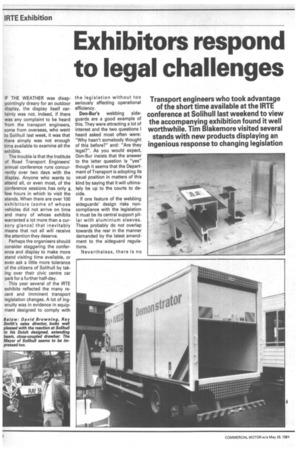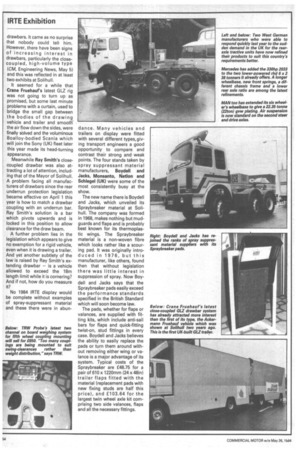Exhibitors respond to legal challenges
Page 70

Page 71

Page 72

If you've noticed an error in this article please click here to report it so we can fix it.
IF THE WEATHER was disappointingly dreary for an outdoor display, the display itself certainly was not. Indeed, if there was any complaint to be heard from the transport engineers, some from overseas, who went to Solihull last week, it was that there simply was not enough time available to examine all the exhibits.
The trouble is that the Institute of Road Transport Engineers' annual conference runs concurrently over two days with the display. Anyone who wants to attend all, or even most, of the conference sessions has only a, few hours in which to visit the stands. When there are over 100 exhibitors (some of whose vehicles did not arrive on time and many of whose exhibits warranted a lot more than a cursory glance) that inevitably means that not all will receive the attention they deserve.
Perhaps the organisers should consider staggering the conference and display to make more stand visiting time available, or even ask a little more tolerance of the citizens of Solihull by taking over their civic centre car park for a further half-day.
This year several of the IRTE exhibits reflected the many recent and imminent transport legislation changes. A lot of ingenuity was in evidence in equipment designed to comply with the legislation without too seriously affecting operational efficiency.
Don-Bur's webbing sideguards are a good example of this. They were attracting a lot of interest and the two questions I heard asked most often were: "Why hasn't somebody thought of this before?" and: "Are they legal?". As you would expect, Don-Bur insists that the answer to the latter question is "yes" though it seems that the Department of Transport is adopting its usual position in matters of this kind by saying that it will ultima.tely be up to the courts to decide.
If one feature of the webbing sideguards' design risks noncompliance with the legislation it must be its central support pillar with aluminium sleeves. These probably do not overlap towards the rear in the manner demanded by the latest amendment to the sideguard regulations.
Nevertheless, there is no doubt that these webbing straps from the USA, manufactured under licence by Don-Bur, would effectively satisfy the prime requirements of the regulations — to prevent cyclists or pedestrians falling under the vehicle's rear wheels. Their two big advantages compared with steel, aluminium, or even the latest grp models are their low weight and that they can be removed and refitted quickly and easily.
The Don-Bur body which was used to show off these sideguards is itself innovative. The Spacemaster is a sliding door body which allows enough internal width, 2.451m (8ft 0.5in), for two metric pallets to be carried side by side.
The 7.3m (24ft) long Spacemaster demonstrator has four doors each side which close flush with each other, unlike a conventional twin-tracked sliding door body. Linkages in the doors are connected to recessed over-centre handles. Releasing these allows the doors to swing our from the bottom and pass over each other, running on the novel Don-Bur top-rail extrusion.
The Stoke-based manufacturer is so satisfied with the sealing and insulation of the doors that it says the Spacemaster body may be used for carrying chilled and refrigerated products. The doors' grp exterior panels sandwich an insulating layer of Styrofoam.
Seddon Atkinson has estab lished a reputation for squeezing in eye catching exhibits at IRTE shows. This year it was the 401 6 x 4 tractive unit (CM, May 19) which stole the limelight and prompted yet more discussion as to whether 6 x 4, 6 x 2 or 4 x 2 was the right way to go for 38 tonnes. The Rolls-Royce (Perkins) 300L1 engined unit on display was built to satisfy Petroleum Regulations, but according to Seddon Atkinson's weighbridge ticket, nonetheless has a competitively low kerb weight of 7,040kg (6.93 tons) with a full fuel tank, aluminium alloy wheels and no fifth wheel coupling. However, if it is ultra low kerb weight in a 6 x 4 that you are after then Seddon Atkinson's soon-to-be unveiled 301, Cummins LTA-10 290 powered unit will probably pose an even greater challenge to Foden's current dominance of this sector of the 38 tonne market.Seddon Atkinson reckons this will tip the scales at 6,610kg.
Norde suspension, which has some interesting detail differences from Foden's FF20 rubber suspension, is now a standard fitment on all Seddon Atkinson multi-wheelers.
One questioner in the IRTE conference centre wanted to know the logic behind last year's Construction and Use amendment which increased the permissible gross weight for articulated vehicles, but neglected
drawbars. It came as no surprise that nobody could tell him. However, there have been signs of increasing interest in drawbars, particularly the closecoupled, high-volume type (CM, Engineering News, May 5) and this was reflected in at least two exhibits at Solihull.
It seemed for a while that Crane Fruehauf's latest GLZ rig was not goirig to turn up as promised, but some last minute problems with a curtain, used to bridge the small gap between the bodies of the drawing vehicle and trailer and smooththe air flow down the sides, were finally solved and the voluminous Boalloy-bodied Scania which will join the Sony (UK) fleet later this year made its head-turning appearance.
Meanwhile Ray Smith's closecoupled drawbar was also attracting a lot of attention, including that of the Mayor of Solihull. A problem facing all manufacturers of drawbars since the rear underrun protection legislation became effective on April 1 this year is how to match a drawbar coupling with an underrun bar. Ray Smith's solution is a bar which pivots upwards and is locked in this position to allow clearance for the draw beam.
A further problem lies in the legislation which appears to give no exemption for a rigid vehicle, even when it is drawing a trailer. And yet another subtlety of the law is raised by Ray Smith's extending drawbar — is a vehicle allowed to exceed the 18m length limit while it is cornering? And if not, how do you measure it?
No 1984 IRTE display would be complete without examples of spray-suppressant material and these there were in abun dance. Many vehicles and trailers on display were fitted with several different types, giving transport engineers a good opportunity to compare and contrast their strong and weak points. The four stands taken by spray suppressant material manufacturers. Boydell and Jacks, Monsanto, Netlon and Schlegel (UK) were some of the most consistently busy at the show.
The new name there is Boydell and Jacks, which unveiled its Spraybreaker material at Solihull. The company was formed in 1968, makes nothing but mudguards and flaps and is probably best known for its thermoplastic wings. The Spraybreaker material is a non-woven fibre which looks rather like a scouring pad. It was originally introduced in 1976, but this manufacturer, like others, found then that without legislation there was little interest in suppression of spray. Now Boy dell and Jacks says that the Spraybreaker pads easily exceed the performance standards specified in the British Standard which will soon become law.
The pads, whether for flaps or valances, are supplied with fitting kits, which include anti-sail bars for flaps and quick-fitting twist-on, stud fittings in every case. Boydell and Jacks believes the ability to easily replace the pads or turn them around without removing either wing or valance is a major advantage of its system. Typical costs of the Spraybreaker are £48.75 for a pair of 610x 1220mm (24 x 48in) trailer flaps fitted with the material (replacement pads with new fixing studs are half this price), and £103.64 for the largest twin wheel axle kit comprising two side valances, flaps and all the necessary fittings.








































































































